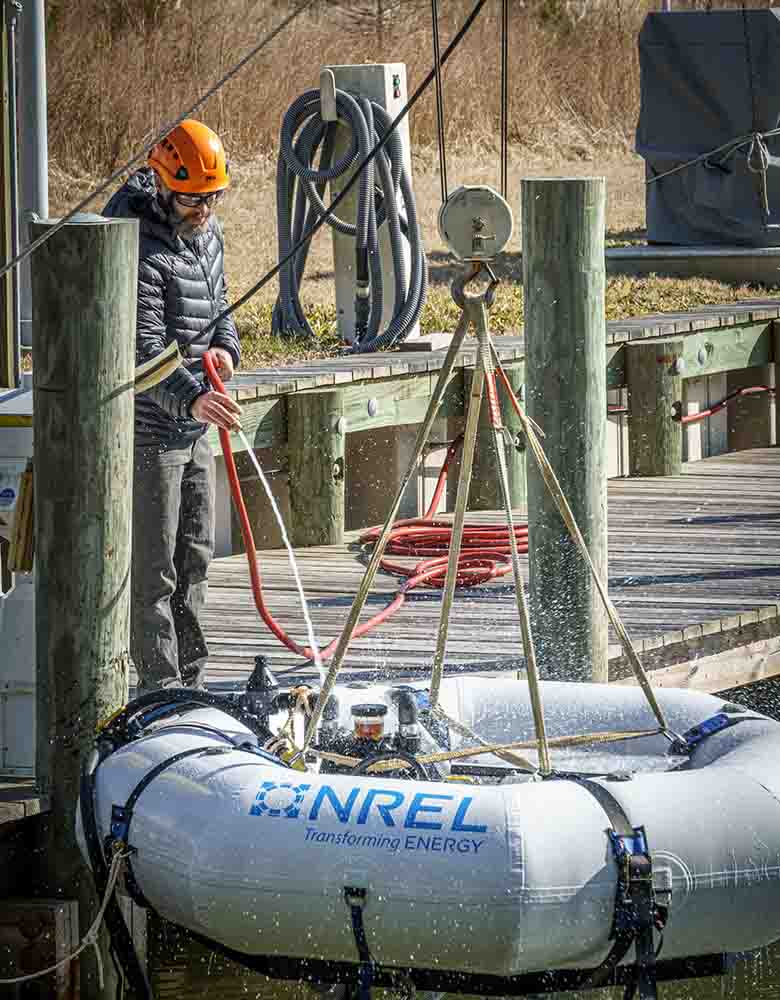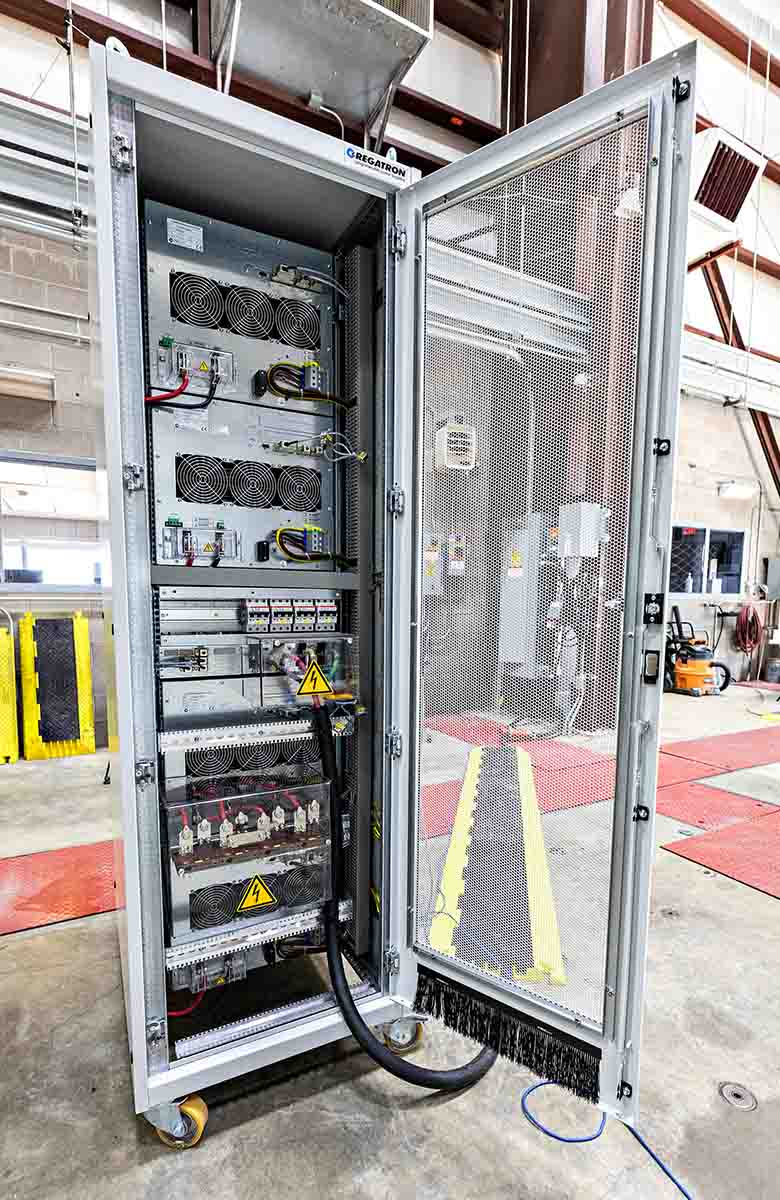The New Grids on the Block
Microgrids and Nanogrids Can Bring Clean Energy to More Communities, and NREL Has the Tools To Help Build Them

Living off big, national grids does not always mean living a grid-free life.
Take the evergreen Isle au Haut off the coast of Maine, for example. Since 1983, the summer tourists and year-long fishing community have gotten their power from a 7-mile-long underwater cable connected to the mainland’s national grid.
Today, that cable is about a decade past its lifespan and would cost about $1.7 million to replace. Or, the community proposed, they could build a new clean energy grid just for their island—a microgrid that could help prevent blackouts, lower energy costs, and reduce carbon emissions.
But despite these many benefits, the 70 islanders were reluctant to try something new and potentially risky. They voted it down.
Isle au Haut’s reluctance makes the National Renewable Energy Laboratory’s (NREL’s) microgrid and nanogrid research all the more vital. Using the laboratory’s latest suite of instruments, grid researchers and technology developers can simulate, validate, and hone these smaller, renewable-energy-based grids—as well as the marine energy, hydropower, and other renewable energy sources and devices that power them—so communities can be confident about bringing their benefits home.
“A lot of these communities are the ones that are being most impacted by climate change,” said Rebecca Fao, a research engineer in NREL’s water power group. “So, by switching to clean energy, they’re helping in their small way to save their communities.”
Many island communities and remote villages, like those dotting Alaska’s vast frontier, are isolated from the state’s larger grid. That isolation forces them to truck, ship, or fly in fuels, which gets expensive and is not always reliable—strong winter storms can waylay much-needed shipments. Power from local, renewable resources, like sun, wind, or water, on the other hand, could be more affordable and reliable and decrease a community’s dependence on imported fuels. But these clean-energy-powered microgrids are not just for the remote; they could become critical backup systems for cities and towns facing a more unpredictable climate.
“It’s more and more likely that we’re going to need to migrate more toward localized power generation, especially for disaster relief,” Fao said. “We’ll need to have a backup plan.”
For example, a nanogrid could run a wave-powered water desalination system to provide clean drinking water to a disaster-struck community. Nanogrids are just smaller versions of microgrids, which can be large enough to power a small city. Both types of miniature grids could come with local jobs and empower communities to take charge of their own energy systems and build energy independence. This local decision-making is especially valuable for communities of color and low-income communities, which have been historically left out of clean energy decisions while living with disproportionately high levels of pollution in their air, water, and soil.
Still, some communities, like Maine’s Isle au Haut, may be wary of these new grids on the block. To quell doubts and continue honing these smaller systems, Fao and her NREL colleagues simulate and study microgrids and nanogrids at the laboratory’s Flatirons Campus. Trying out different scenarios and setups in a virtual setting is safer, cheaper, faster, and lower risk. Plus, technology developers—like those designing wave-powered desalination devices—can see how their early-stage prototypes might function as part of these smaller grids.
“If you ramp right up to building a full-scale device and things go wrong,” Fao said, “it’s a lot more expensive to correct. Slow and steady wins the race.”
NREL’s marine energy researchers already follow Fao’s advice. One team recently created a wave-powered water desalination device. To prepare the device for its first open-ocean trial, the team evaluated their system’s power take-off—which transforms energy from waves, currents, or tides into electricity—on one of NREL’s smaller-scale dynamometers. These dynamometers can imitate ocean forces, like powerful waves, with a controllable, electric motor, so technology developers can learn how well their device or its components might hold up in real ocean conditions.
Researchers can also use NREL’s smaller dynamometers, along with the laboratory’s grid emulators, to mimic electric grids, including microgrids and nanogrids, to analyze how their technologies might serve these miniature systems. The laboratory already has a 50-kilowatt direct current grid emulator and will soon welcome an alternating current bidirectional grid emulator. With that, Fao said, researchers can emulate how multiple technologies work together to form these small-scale grids.
“Say you want to integrate your wave energy device with a small wind turbine,” Fao said. “You can. The grid emulators can act as both and simulate both.”

Users can program these grid emulators to mimic whatever they want their target grid to look like. That could mean simulating how energy storage systems (like batteries or pumped storage hydropower) couple with energy sources (like tidal energy devices) to learn how many houses that grid could power.
“Whatever the case might be,” Fao said, “you’d code all that up and then hook the technologies together.”
NREL’s grid emulators are essentially programmable power supplies. Technology developers can test out their theoretical designs in purely virtual simulations, emulating everything from complex grids to real-world conditions, including extreme ocean waves. Or, they can pair the grid emulators with physical hardware, like NREL’s wave-powered desalination device, to validate even full-scale prototypes.
And now, developers can perform even more in-depth analysis, thanks to the Wave Energy Converter SIMulator software. This model, which was developed by NREL and Sandia National Laboratories, can simulate how devices perform at sea. Recently, Fao and her team paired the software with the laboratory’s grid emulators and small dynamometers to simultaneously model a wave energy device while driving physical power electronics using the same wave conditions. Together, the model and the dynamometers can exchange information, too, to provide a more accurate evaluation of components and their potential performance.
When a full-scale prototype is nearly ready for the real world, technology developers will soon be able to put it through one final trial on land. In 2023, NREL will install a large amplitude motion platform that can emulate many of the sea states found in United States waters. This motion platform, along with the other specialized validation capabilities described above, will help technology developers design marine energy systems that are optimized for tomorrow’s microgrids and nanogrids.
For Isle au Haut and many more American communities, cutting the cable—both real and metaphorical—can feel risky. But, Fao said, “Climate change is likely to cause more extreme weather events that put our current grid at risk. It’ll be more and more important to have a backup plan if and when that grid is cut off.”
Take a virtual 360 tour of NREL’s water power facilities to explore the laboratory’s instruments in three dimensions. And subscribe to the NREL water power newsletter, The Current, to make sure you don’t miss a water power update.
Last Updated May 28, 2025
